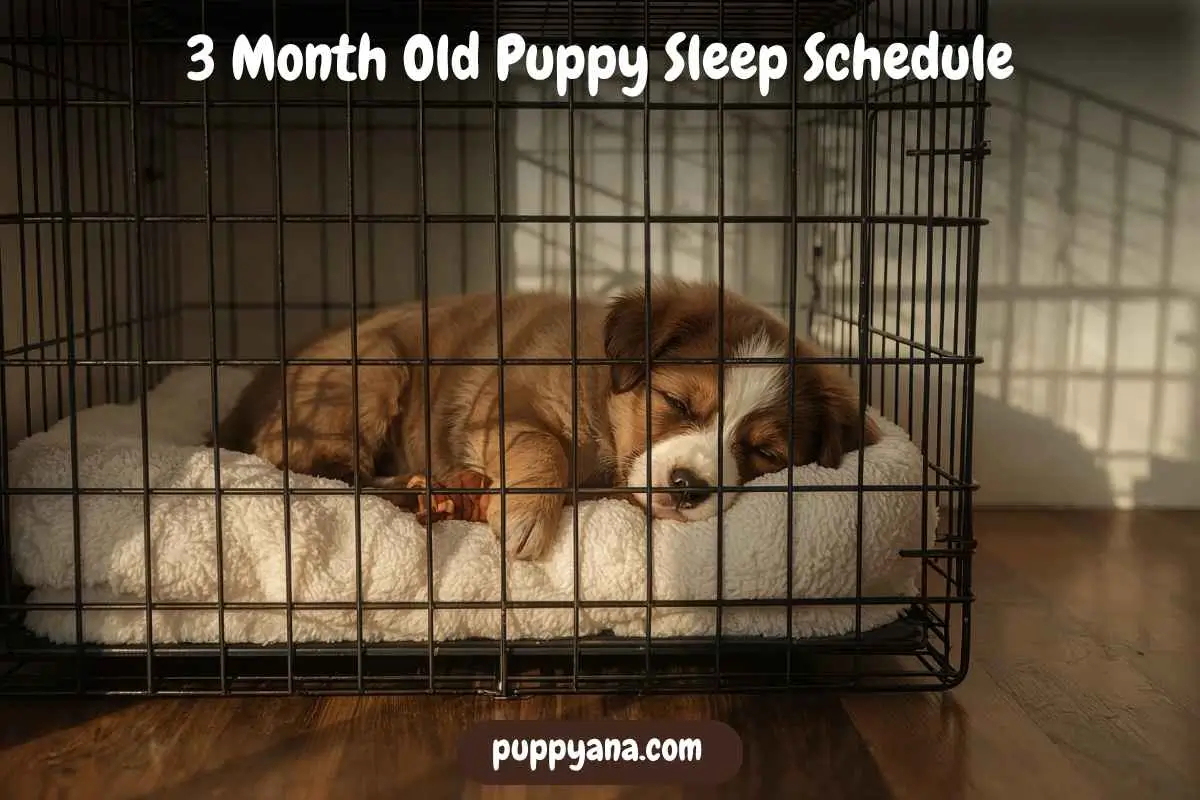Knowing how much to feed a puppy can be confusing. Every bag of food says something different, every vet gives slightly different advice, and your puppy always seems hungry.
So how do you know you’re feeding the right amount?
If you’re raising a tiny Yorkie or a fast-growing Lab, this guide walks you through accurate puppy feeding amounts, how often to feed, what affects portion size, and when to adjust as your dog grows. It’s based on real experience raising puppies of all sizes, and it follows the guidance of the AKC, PetMD, and veterinarians from VCA Animal Hospitals.
Let’s make your puppy’s mealtime easy, healthy, and predictable.
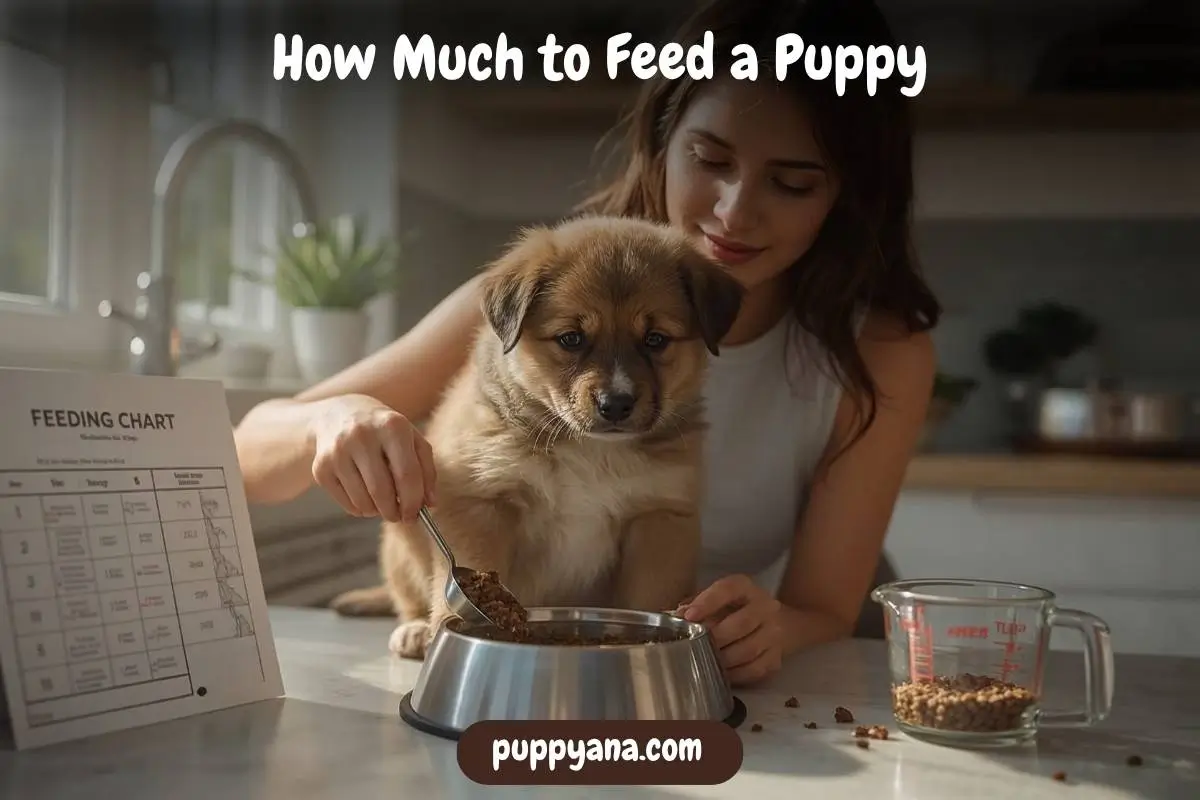
Table of Contents
ToggleHow Much to Feed a Puppy: Quick Answer
Puppies should be fed 3 to 4 meals a day, and the amount is based on their:
- Age
- Current weight
- Expected adult size
- Type of food (kibble, wet, raw)
For example:
- A 10-pound puppy may eat around 1 ½ to 2 cups of kibble per day, divided into 3 meals
- A large breed puppy (like a Lab) at 12 weeks old might eat 3–4 cups daily, split into 3–4 meals
Always check your food label’s feeding guidelines, but adjust for your puppy’s energy level, body condition, and stool quality.
Factors That Affect How Much to Feed
Not all puppies need the same amount, even at the same age. Here’s what changes the numbers:
1. Breed and Adult Size
A Mini Dachshund doesn’t grow like a Golden Retriever. Feeding too much (or too little) for your dog’s predicted size can cause growth problems.
Use the puppy size calculator to estimate adult weight.
2. Age and Growth Stage
Young puppies (8–12 weeks) need more frequent meals since their bellies are small, but their energy demands are high.
Older puppies (5+ months) grow more slowly and can start transitioning to twice-daily feeding.
3. Type of Food
Kibble and wet food have different caloric densities. Feeding 1 cup of wet food doesn’t equal 1 cup of dry. Always check the calories per cup or can.
4. Activity Level
Highly active puppies or working breeds burn more energy. Couch potatoes eat less. Matching food to activity helps avoid underfeeding or excessive weight gain.
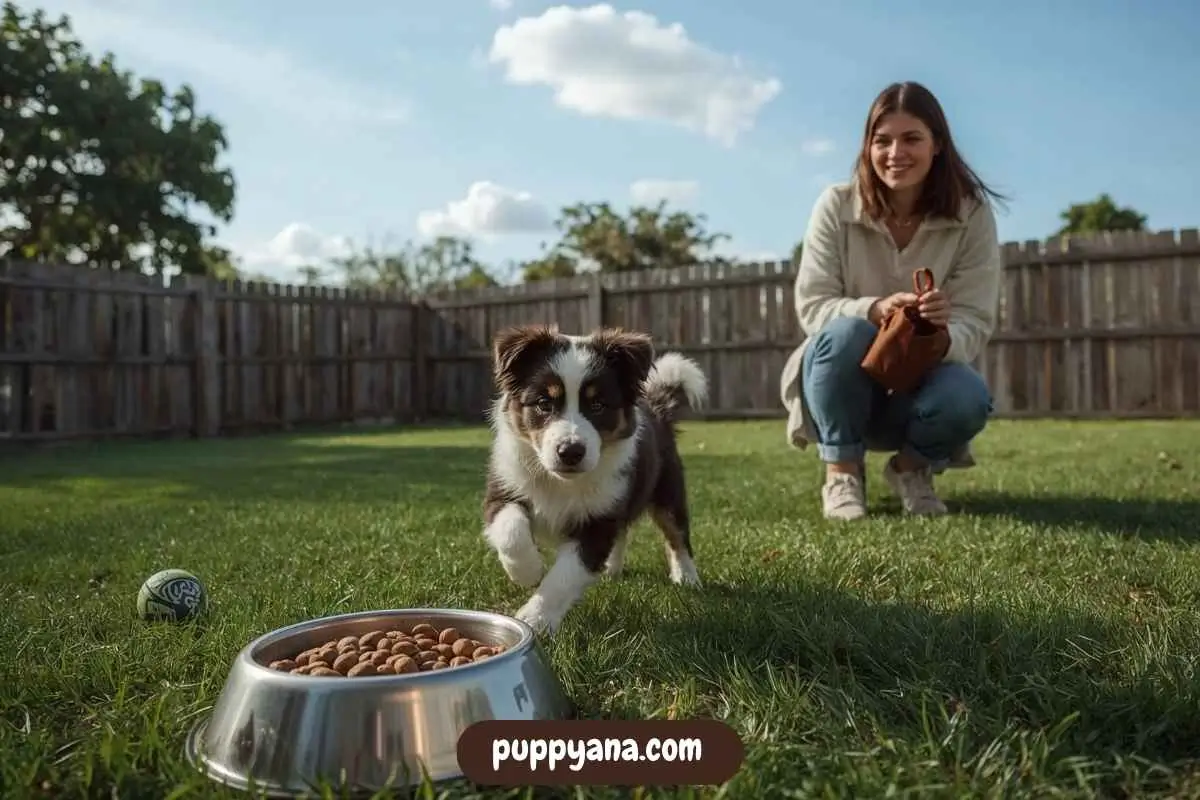
Puppy Feeding Amount Chart by Age and Weight
This chart gives a general estimate, assuming dry puppy kibble and average activity levels. For best results, adjust slightly based on your brand’s calorie content and your pup’s metabolism.
| Puppy Weight | 8–12 Weeks | 3–4 Months | 5–6 Months | 6–12 Months |
|---|---|---|---|---|
| 5 lbs | 1 – 1½ cups | ¾ – 1 cup | ½ – ¾ cup | ½ cup |
| 10 lbs | 1¾ – 2¼ cups | 1½ – 2 cups | 1 – 1½ cups | ¾ – 1 cup |
| 20 lbs | 2½ – 3½ cups | 2–3 cups | 1¾ – 2½ cups | 1½ – 2 cups |
| 40 lbs | 3½ – 4¾ cups | 3–4¼ cups | 2½ – 3½ cups | 2¼ – 3 cups |
| 60+ lbs | Work with a vet for breed-specific plans |
These are just starting points. Large and giant breeds like German Shepherds, Labs, and Goldens often benefit from large-breed-specific formulas with tightly controlled calcium and phosphorus. Ask your vet for a tailored growth diet.
How Often to Feed a Puppy
General schedule by age:
- 8–12 weeks old – 4 meals per day
- 3–6 months old – 3 meals per day
- 6–12 months old – 2 meals per day
I’ve helped raise two Labrador litters, and once we dropped from 4 meals to 3 at 12 weeks, they adjusted easily, until dinner was late. Keep mealtimes consistent to avoid begging, scavenging, or digestive changes.
According to VCA’s puppy feeding advice, sticking to set meal times also helps with house training and energy management.
How to Adjust Feeding as Your Puppy Grows
Your puppy’s food needs will change as they go through different stages of early growth. A portion that’s perfect at 10 weeks may become too small or too large, just a few weeks later.
Here’s a basic growth-based feeding guide:
| Age | Change to Watch For | What to Adjust |
|---|---|---|
| 8–12 weeks | Rapid growth | Stick to 4 meals a day, increase portion slightly every 2 weeks |
| 3–4 months | Teething, energy spikes | Maintain calorie intake, switch to 3 meals |
| 5–6 months | Slower growth in medium breeds | Start reducing total calories slightly |
| 6–12 months | Early adolescence, adult body shape forming | Transition to 2 meals, reduce puppy food over time |
Always measure your puppy weekly and assess their body condition, not just their weight. If your puppy rapidly gains fat or loses energy, it’s time for a minor adjustment.
Signs You’re Feeding the Wrong Amount
It’s common to under- or over-feed, even with the right chart. Here’s what to watch for:
Signs of underfeeding:
- Visible ribs, hips, or spine
- Low energy throughout the day
- Poor coat quality
- Loose, sloppy stool or yellow poop
Signs of overfeeding:
- Rapid weight gain
- Pot belly after meals
- Soft or inconsistent stool
- Lack of energy due to bloating
- Excessive begging even when full
Always use your eyes and hands, not just the chart. A healthy puppy should have a visible waistline from above and a slight tummy tuck from the side.

Real-Life Feed Example: 12-Week-Old Golden Retriever
Meet Luna, a 3-month-old Golden Retriever I helped foster.
At 12 weeks, she weighed 20 pounds. On her high-quality large breed kibble (which had 365 calories per cup), her feeding looked like this:
- Morning: 1 cup
- Midday: 1 cup
- Evening: 1¼ cups
We watched her stool, adjusted ⅛ of a cup as needed, and she hit every weekly weight gain target without bloating. By 6 months, she was thriving on two larger meals.
Every puppy has unique needs, even littermates. That’s why watching body condition is king.
What to Do If Your Puppy Skips a Meal
Puppies are usually excited to eat, so when they skip a meal, it catches attention fast.
Here’s what to consider if your puppy doesn’t eat:
Possible reasons:
- Too much play or stress right before mealtime
- Full from treats or chews
- Distraction from environment (new visitors, noise, travel)
- Minor sugar drop or upset tummy
Try this:
- Offer the meal 15–20 minutes later in a quieter space
- Remove uneaten food after 20 minutes, don’t keep it out
- Avoid offering more treats “just to get them to eat”
If your puppy misses more than one full meal or shows symptoms like fatigue, vomiting, or diarrhea, call your vet right away.
For occasional picky eaters, PuppyAna recommends rotating healthy toppers like bone broth, soft mixer bites, or a splash of warm water on kibble to increase interest without creating bad habits.
Wet vs. Dry vs. Raw: Do Feeding Amounts Change?
Yes, your feeding method changes how much your puppy eats.
| Type | Pros | Feeding Notes |
|---|---|---|
| Dry (kibble) | Easy, stores well | Measure in cups; check calories per cup |
| Wet (canned) | Higher moisture | Often less dense; may need more volume |
| Raw/fresh food | Customizable | Requires vet-monitored feeding plans and proper balance |
Always follow the brand’s label. If you’re using mixed types (like kibble + wet), calculate combined calories, not just portion size.
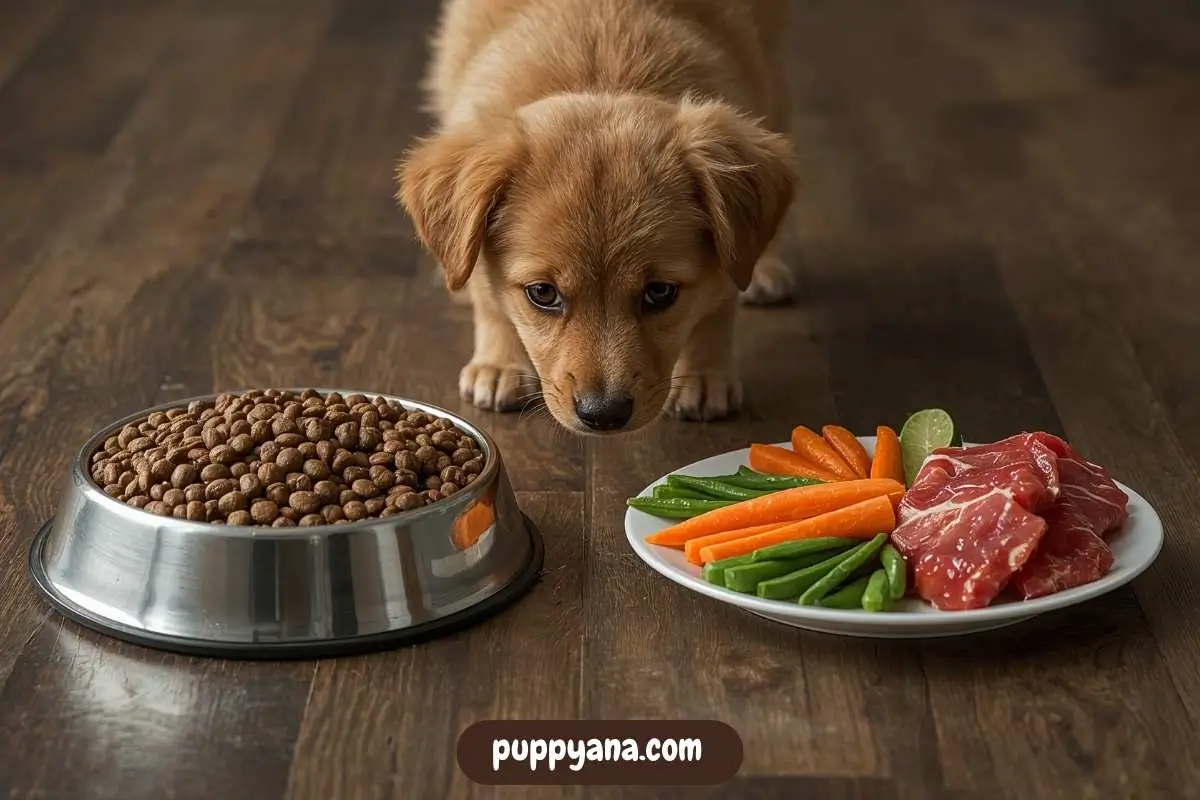
Should You Free Feed a Puppy?
Free feeding (leaving food out all day) is not recommended for most puppies. It can:
- Make potty training harder
- Cause overeating or under-eating
- Be hard to track appetite changes
- Encourage picky behavior
Instead, offer meals for 15–20 minutes, 3–4 times a day, and then pick them up if not eaten. This builds structure, improves digestion, and helps with measuring performance.
Only free feed on vet advice with dogs who struggle with appetite or medical needs.
How to Transition Puppy to a New Food Safely
At some point, you’ll need to change brands, switch formulas, or transition from puppy to adult food. Doing it too fast can upset your puppy’s stomach literally.
Follow the 7-Day Transition Rule:
| Day | Old Food | New Food |
|---|---|---|
| 1–2 | 75% | 25% |
| 3–4 | 50% | 50% |
| 5–6 | 25% | 75% |
| 7+ | 0% | 100% |
Watch for soft stool, vomiting, or sudden itchiness. These may signal a food intolerance or digestive struggle.
PuppyAna’s Feeding Tip
PuppyAna reminds new puppy parents that meal time is not just about nutrition, it’s also a chance to train impulse control, build structure, and prevent resource guarding.
Use those daily mealtimes to reinforce “sit,” “wait,” and calm behavior. Feeding becomes part of your training day. You build trust the slow, simple way, 1 bite at a time.
Do Puppies Need Supplements in Their Food?
Additional vitamins might sound like a good idea, but most puppies fed a complete, vet-approved puppy food do not need supplements added to their daily meals.
Adding too much calcium or phosphorus, in particular, can cause joint and bone issues, especially in fast-growing large breeds.
Supplements may be appropriate if:
- Your vet diagnoses a deficiency
- You’re feeding a fresh, raw, or homemade diet
- Your puppy has skin, digestive, or immunity concerns
I worked with a family whose 5-month-old Boxer pup had flaky skin. We added a vet-recommended omega-3 supplement, and by week 3, her coat looked shinier and less itchy.
Always ask your vet before adding supplements. Too much of a “good thing” can throw off your puppy’s nutrition balance.
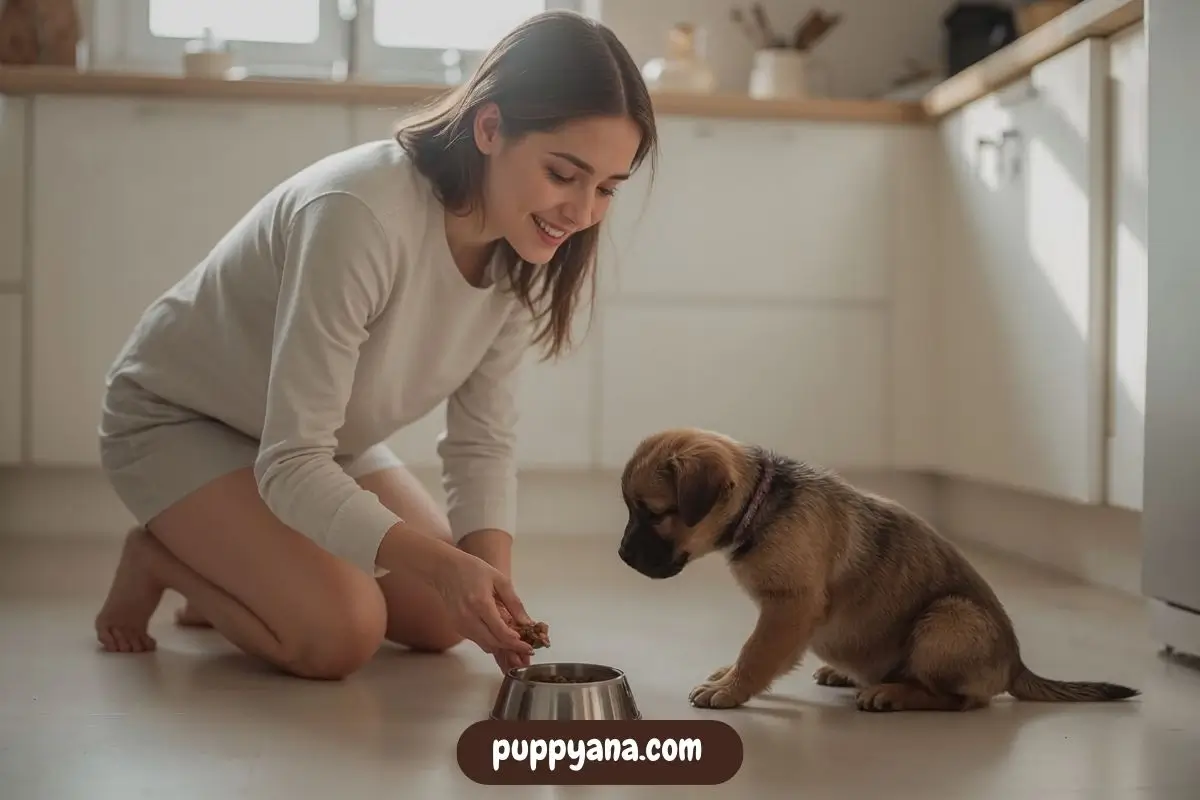
Conclusion
Puppies grow fast and eat often, but figuring out how much to feed a puppy shouldn’t be stressful. Start with your dog’s age, weight, and predicted size. Use food label recommendations as a guide, then adjust based on activity and body condition.
Consistency = confidence. Feed on time, in the right portions, and with structure, and you’ll raise a healthy, happy, growing pup.
Frequently Asked Questions
How much should I feed my puppy per meal?
It depends on age and weight. Most small puppies get ⅓ to 1 cup per meal. Medium to large ones may eat ¾ to 1½ cups per meal.
How do I know if I’m feeding the right amount?
Check your puppy’s body shape (not just the scale). Healthy puppies are padded but not round. You should feel ribs but not see them clearly.
When should I switch from three to two meals per day?
Between 5–6 months for most breeds. Large and giant breeds may stay on 3 meals longer.
Should I feed by volume (cups) or calories?
Calories are more accurate, especially across different brands. Cups can vary in density. Always check the calories per cup on your dog’s food label.
Can I top kibble with wet or raw food?
Yes, but reduce kibble slightly to account for added calories. Always adjust over a few days and watch digestion.
Is my puppy whining because they’re hungry?
Sometimes, but it could also be boredom, stress, or habit. Feed by schedule, not by guessing need based on whining.



